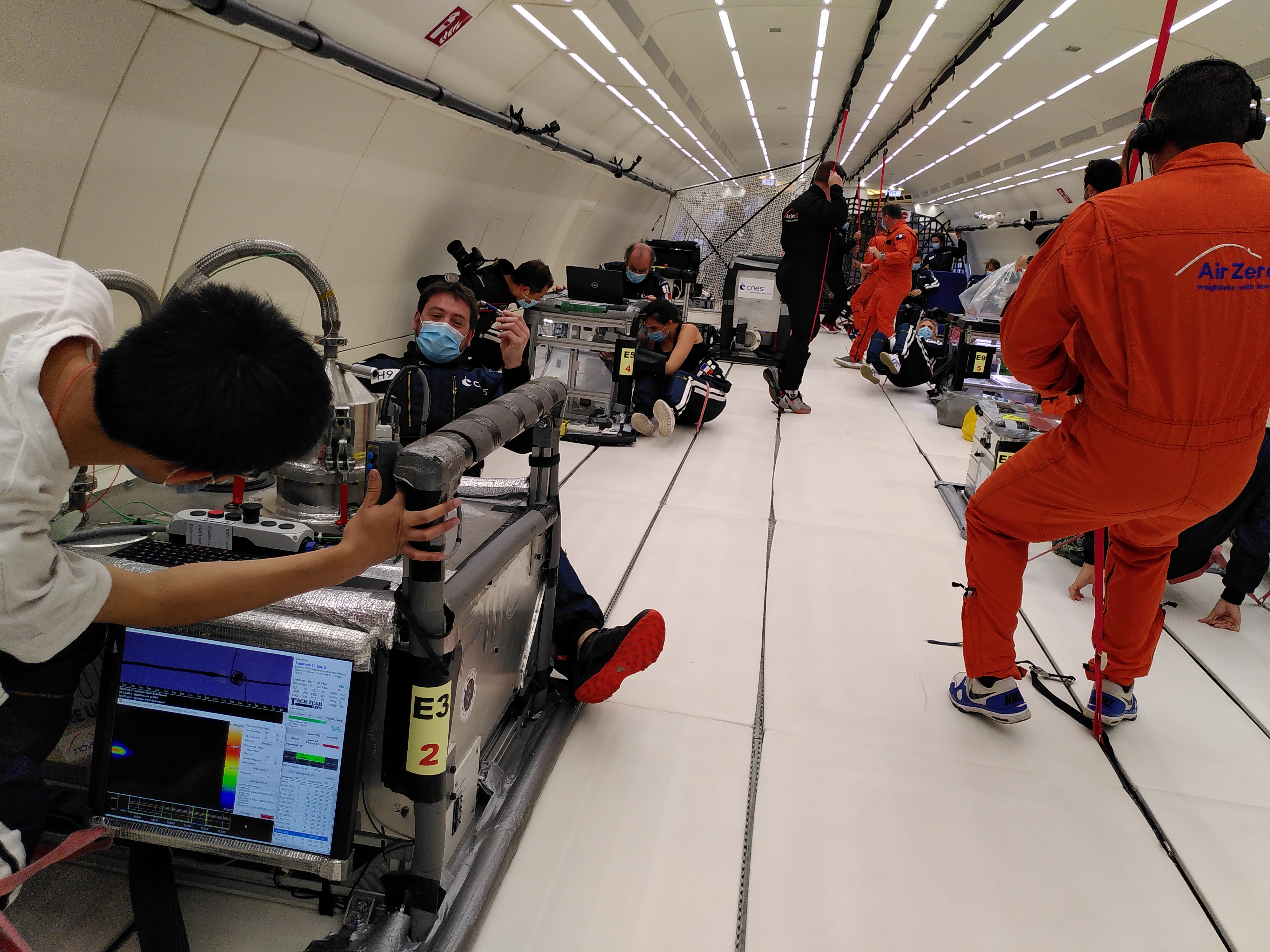This page is dedicated to the investigations lead on the rig DIAMONDS (Detection of Ignition And Mitigation Onboard for Non-Damaged Spacecrafts) by ∂'Alembert on flames spreading in microgravity.
Breaking News (June 24th, 2020):
CNES launches the 1st Parabolic Flight Campaign (CNES VP 148) after the COVID-19 crisis.
Watch DIAMONDS and TELEMAQUE both aboard the Novespace airplane along the 2nd flight.
Teams from ∂'Alembert in between DIAMONDS (left) and TELEMAQUE (right) setups onboard:
- lower row (from left to right) : P. Challande (TELEMAQUE), G. Legros (DIAMONDS), H. Moingeon (TELEMAQUE)
- upper row (from left to right): Y. Li (DIAMONDS), J.-M. Citerne (DIAMONDS), R. Marchiano (TELEMAQUE), S. Vincent (TELEMAQUE)
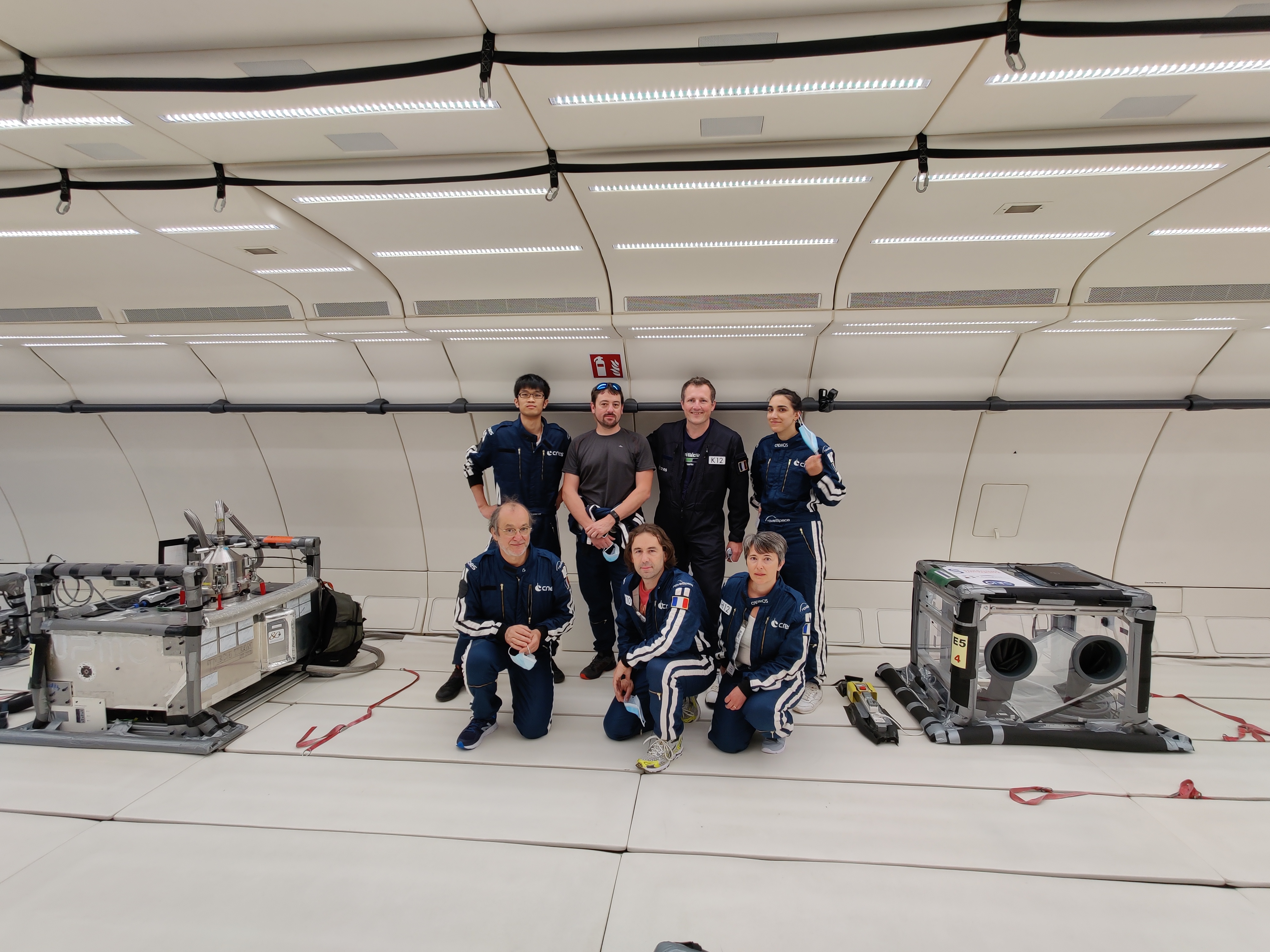
Recent publications and communications
G. Legros and J.L. Torero. Phenomenological model of soot production inside a non‐buoyant laminar diffusion flame. Proceedings of The Combustion Institute, 35:2545-2553, 2015. [link].
G. Jomaas, J.L. Torero, C. Eigenbrod, J. Niehaus, S.L. Olson, P.V. Ferkul, G. Legros, C. Fernandez-Pello, A.J. Cowlard, S. Rouvreau, N.N. Smirnov, O. Fujita, J.S. T'ien, G.A. Ruff, and D.L. Urban. Fire Safety in Space - Beyond Flammability Testing of Small Samples. Acta Astronautica, 109:208-216, 2015. [link].
R. Raffegeau. Quand la NASA joue avec le feu. Science et Vie Junior (Juin 2016) 46–49 [link].
J.-M. Citerne, H. Dutilleul, K. Kizawa, M. Nagachi, O. Fujita, M. Kikuchi, G. Jomaas, S. Rouvreau, J.L. Torero, and G. Legros. Fire safety in space - Investigating flame spread interaction over wires. Acta Astronautica, 126:500-509, 2016. [link]
R. Prud'homme, G. Legros, and J.L Torero. Combustion in microgravity: The French contribution. Comptes Rendus Mécanique, 345:86-98, 2017. [link].
M. Nagachi, F. Mitsui, J.M. Citerne, H. Dutilleul, A. Guibaud, G. Jomaas, G. Legros, N. Hashimoto, O. Fujita. Can a spreading flame over electric wire insulation in concurrent flow achieve steady propagation in microgravity? Proceedings of The Combustion Institute, 37:4155-4162, 2019. [link].
A. Guibaud, J.M.Citerne, J.M. Orlac'h, O. Fujita, J.-L. Consalvi, J.L. Torero, G. Legros. Broadband Modulated Absorption/Emission technique to probe sooting flames: implementation, validation, and limitations. Proceedings of The Combustion Institute, 37:3959-3966, 2019. [link].
D.L. Urban, P. Ferkul, S. Olson, G.A. Ruff, J. Easton, J.S. T'ien, Y.-T. T. Liao, C. Li, A.C. Fernandez-Pello, J.L. Torero, G. Legros, C. Eigenbrod, N. Smirnov, O. Fujita, S. Rouvreau, B. Toth, G. Jomaas. Flame Spread: Effects of Microgravity and Scale. Combustion & Flame, 199:168-182, 2019. [link].
M. Nagachi, F. Mitsui, J.-M. Citerne, H. Dutilleul, A. Guibaud, G. Jomaas, G. Legros, N. Hashimoto, and O. Fujita,
Effect of ignition condition on the extinction limit for opposed flame spread over electrical wires in microgravity,
Fire Technology , 56:149-168, 2020.[link].
A. Guibaud, J.-L. Consalvi, J.-M. Orlac’h, J.-M. Citerne, and G. Legros
Soot production and radiative heat transfer in opposed flame spread over a polyethylene insulated wire in microgravity,
Fire Technology ,56:287-314, 2020. [link].
A. Guibaud, J.-M. Citerne, J.-L. Consalvi, O. Fujita, J.L. Torero, and G. Legros
Experimental evaluation of flame radiative feedback: methodology and application to opposed flame spread over coated wires in microgravity,
Fire Technology , 56:185-207, 2020. [link].
A. Guibaud, J.-M. Citerne, J.-L. Consalvi, and G. Legros
On the effects of opposed flow conditions on non-buoyant flames spreading over polyethylene-coated wires - Part 1: spread rate and soot production,
Combustion & Flame, 221:168-182, 2020. [link]
A. Guibaud, J.-M. Citerne, J.-L. Consalvi, and G. Legros
On the effects of opposed flow conditions on non-buoyant flames spreading over polyethylene-coated wires - Part 2: soot oxidation quenching and smoke release,
Combustion & Flame, 221:544-551, 2020. [link]
A. Guibaud, J.-M. Citerne, J.-L. Consalvi, and G. Legros
Pressure Effects on the Soot Production and Radiative Heat Transfer of Non-Buoyant Laminar Diffusion Flames Spreading in Opposed Flow over Insulated Wires,
Combustion & Flame, 222:530-543, 2020. [link]
J.-L. Consalvi, A. Guibaud, A. Coimbra, J.-M. Citerne, and G. Legros
Effects of oxygen depletion on soot production, emission and radiative heat transfer in opposed-flow flame spreading over insulated wire in microgravity,
Combustion & Flame, 230:111447, 2021. [link]
M. Nagachi, J.-M. Citerne, H. Dutilleul, A. Guibaud, G. Jomaas, G. Legros, N. Hashimoto, and O. Fujita
Effect of Ambient Pressure on the Extinction Limit for Opposed Flame Spread over an Electrical Wire in Microgravity,
Proceedings of The Combustion Institute , 38:4767-4774, 2021. [link]
A. Guibaud, J.-M. Citerne, J.-L. Consalvi, J.L. Torero, O. Fujita, M. Kikuchi, P. Ferkul, N. Smirnov, G. Jomaas, B. Töth, S. Rouvreau, and G. Legros
Accessing the soot-related radiative heat feedback in a flame spreading in microgravity: optical designs and associated limitations,
Proceedings of The Combustion Institute , 38:4805-4814, 2021.[link]
TV show 'Carnets de vol' about parabolic flights in general and our experiment DIAMONDS more specifically
Rationales
For several decades, many sound scientific works on fire growth and the movement of smoke and heat have been providing the engineers with the information and tools that are necessary in the design of fire detection and the definition of the subsequent procedures. However, due to the specific conditions encountered in spacecraft, the usual tools for normal gravity fire detection design needs to be at least assessed into realistic space conditions and probably modified according to the discrepancies among detection thresholds in 1g and 0g, that could lead to unappropriate procedures, then disasters, following a misdetection -or a non-detection- in microgravity.
As a result, NASA launched the SAFFIRE (SpAcecraFt FIRe safety Experiment) project five years ago. This project allows for a close collaboration among American, European, Japanese, and Russian partners gathered in an international topical team. Within the framework of this project, fires are to spread over samples of real length scale (~1m) within real time scale (~20 minutes) into six actual spacecrafts, i.e. Cygnus supply vehicles. These extraordinary experiments are a worldwide première to date into the challenging Mission To Mars. While the results are still processed, the first experiment operated in June 2016 was really successful [link].
Concomitantly, JAXA launched the FLARE (Flammability Limit At REduced gravity) project (see the official sticker below). This project aims at the definition of the conditions that systematically lead to flame extinction within the context of manned spacecraft. The aforementioned international topical team also takes part in the FLARE project.
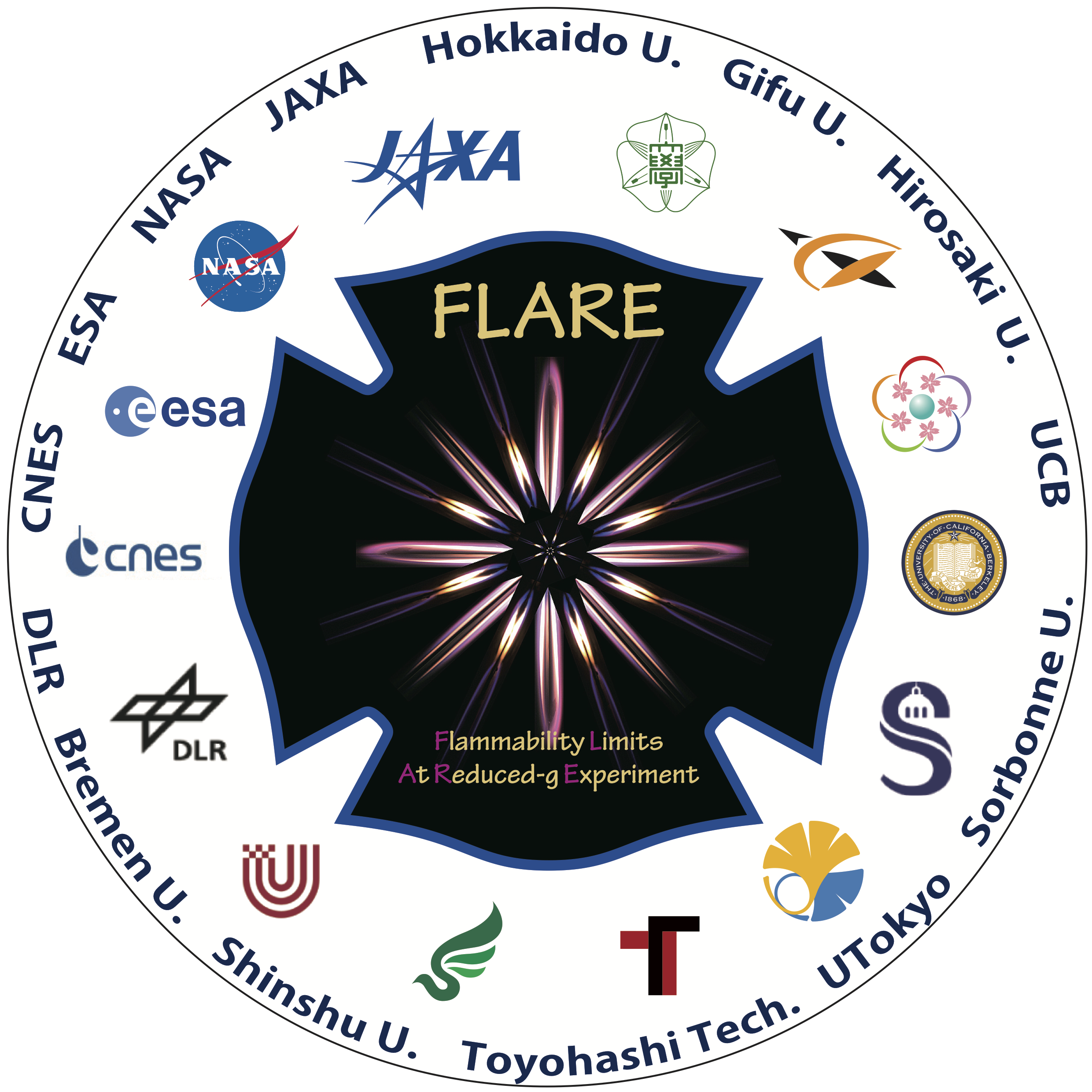
Figure 1: Official sticker of the FLARE project.
The experiments conducted at ∂'Alembert contribute to these international projects.
Works at ∂'Alembert
A rig called DIAMONDS (Detection of Ignition and Adaptive Mitigation Onboard for Non-Damaged Spacecrafts) [link] has been custom-designed at ∂'Alembert to enable the study of flame spreading over the coating of cylindrical wires in microgravity obtained through parabolic flights. This configuration of flame spread is one of those that the FLARE project investigates more specifically.
The schematic shown in Fig.1 introduces the combustion chamber that allows for the strict confinement of the flame spreading over a set of wires.
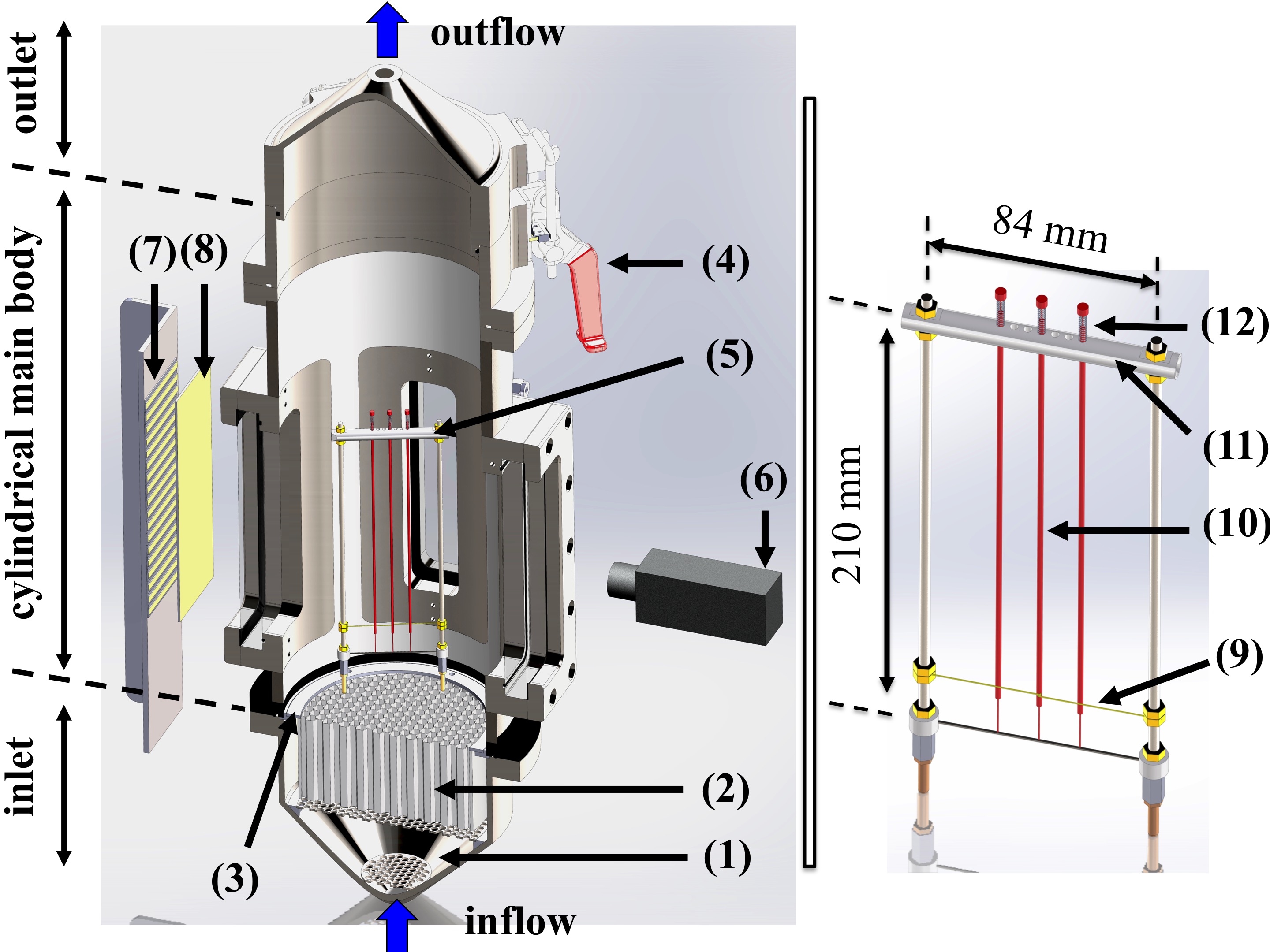
Figure 2: On the left, schematic of the combustion chamber designed for the parabolic flights. (1) Conical part filled with glass beads; (2) stainless steel hon- eycomb; (3) stainless steel ring; (4) latch clamp for top end locking; (5) sample holder; (6) camera; (7) set of LEDs; (8) diffusive screen. On the right, schematic of the sample holder (5) enabling the 3-wire configuration. (9) Kanthal wire; (10) polyethylene coated wire; (11) 10 mm diameter machinable ceramic rod; (12) stainless steel spring.
Figure 2 displays a sequence of frames recorded by the camera (6) capturing the backlight provided by the LEDs (7), as shown in Fig.1. Due to the angle between the line-of-sight of the camera and the normal to the plane containing the 3 wires, a distortion arose and was amplified with the streamwise coordinate, z, as shown by the slope of the white dotted lines in Fig.2. To delay the ignition of the central wire coating, four and five wraps of igniting wire (see (9) in Fig.1) were made around the central wire and the lateral ones, respectively. During the ignition procedure (5 s), the energy deposited was about 20% lower on the central wire than on the lateral ones. As a result, the spread over the central wire's coating was delayed, as shown on the frame captured at t=4.35s.
Two opposite trends may be revealed due to the potential interaction among these flame spreads. The reduced energy deposited on the central wire coating and the oxygen dilution by the combustion products released by the lateral flames would tend to magnify the initial spread delay. Contrarily, the preheating of the central wire coating by the heat released by the lateral flames may accelerate the central spread. As shown by the sequence of frames in Fig.2, the latter effect governs the interaction of spreads in microgravity for the conditions established.
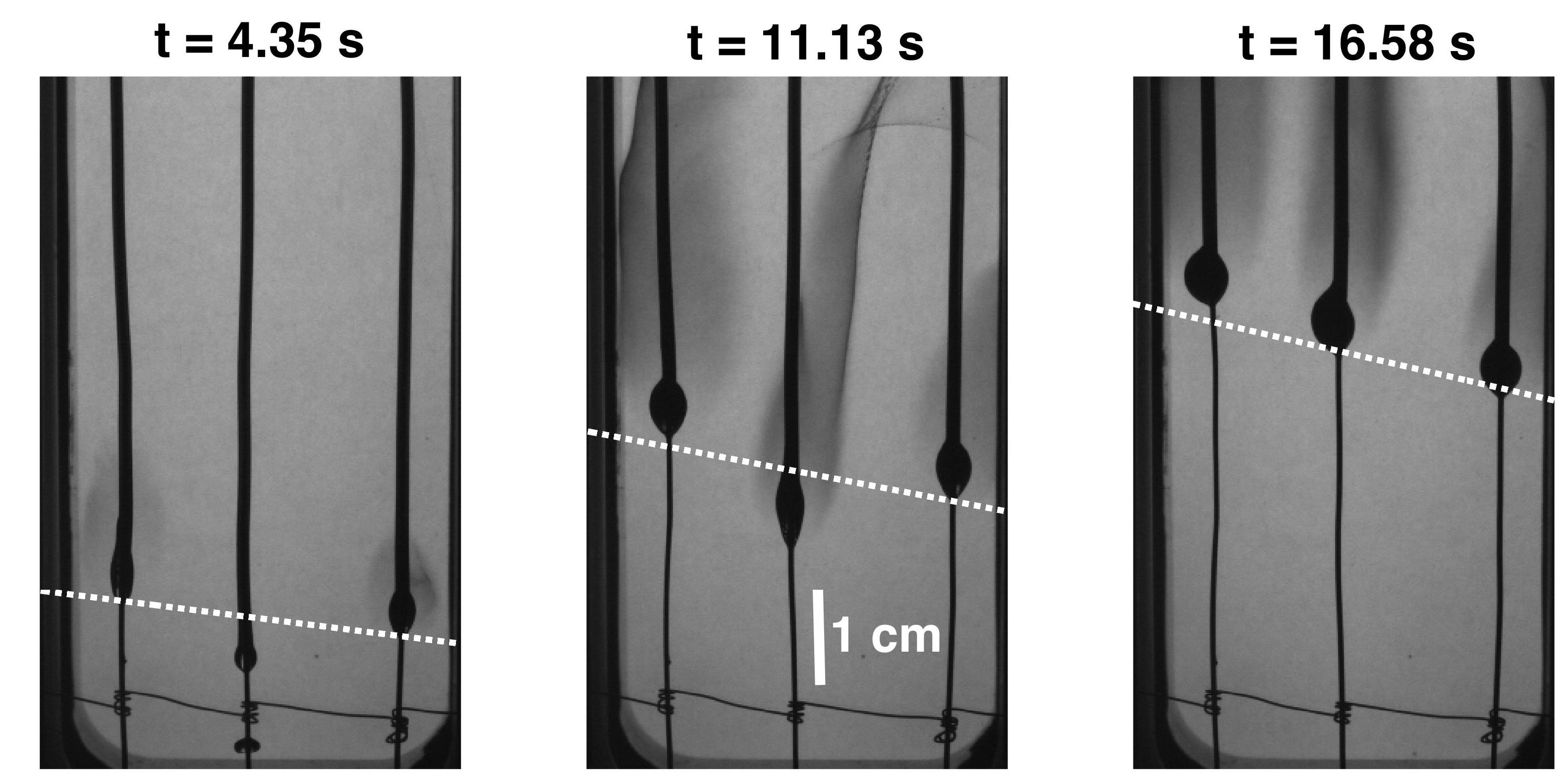
Figure 3: sequence of frames recorded along the concomitant spreads over three wires in microgravity. The oxidizer flows from the bottom to the top. t=0 is the time when the first wire ignition can be detected. The white dotted lines indicate the location of iso-streamwise coordinate z. The delay between the lateral ignitions and the central one is about 4 s. Click on the picture to watch at the movie of this experiment.
Identical conditions could then be established on ground at normal gravity. The central spread could never catch up with the lateral ones. Although a further theoretical analysis is now required, one can decently speculate that the upward convection at normal gravity magnified due to the fact that buoyancy can partially sweep away the heat released by the lateral flames, and thereby weaken the preheating of the coating. Conversely, in microgravity, radiative transfer - partially directed to the coating - is amplified, especially due to increased residence times in flames and enhanced soot production. As a result, spreading flames established in microgravity may interact at longer length scales that at normal gravity.
Prospects
Within the context of Augustin Guibaud's PhD defended in Octember 2019, we started focusing on the assessment of the conditions that can lead to the extinction of a steady flame spread over 1 wire. This especially requires:
- the experimental evaluation of the local emission rate in the flame, i.e. both soot temperature and volume fraction. To this end, we intend to set up a diagnostics inpired by our Modulated Absorption/Emission technique developped around the ∂'Alembert's laminar coflow axisymmetric burner [link];
- numerical developments to help understand the governing phenomena leading to extinction. This will be conducted in close collaboration with Dr Jean-Louis Consalvi (IUSTI, Marseille, France).

